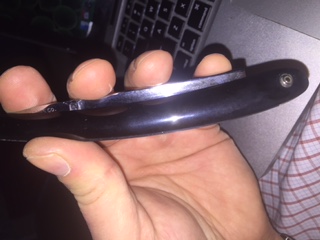Results 1 to 9 of 9
Thread: scales are discolored
Hybrid View
-
12-30-2016, 07:04 PM #1Senior Member

- Join Date
- Oct 2015
- Location
- Pittsburgh, PA
- Posts
- 212
Thanked: 21 scales are discolored
scales are discolored
Hi all,
So I purchased this razor at an antique shop. The blade looked to be in good condition, and I knew the scales needed a bit of help, but could be salvaged - or so I thought. Looked like just some soap spots, and just old age perhaps. Nothing a little elbow grease can't handle...
Anyway, I got it home, polished the blade, and took a bit of MAAS to the scales. Suddenly, it appears the one scale is way off color. In addition, the scales have an odd smell. Like burnt rubber. I've never had issues with using MAAS on scales before. Now I'm wondering if the scales are off gassing, or if the MAAS affected the one scale. Which would be strange b/c the other scale seems unaffected.
The razor itself doesn't show signs of cell rot. So I'm left wondering what the issue might be?
[ATTACH=CONFIG]253326[/ATTACH

Last edited by relli1130; 12-30-2016 at 07:12 PM.
-
12-30-2016, 07:13 PM #2Senior Member



- Join Date
- Mar 2012
- Location
- Thunder Bay, Ontario, Canada
- Posts
- 17,251
Thanked: 3222
I am guessing the scales are made of vulcanite, a hard black vulcanized rubber. The scales probably now have a brownish tinge and smell like Sulphur. I would rub them down with some glycerin and see if that helps.
You can do a site search under "vulcanite scales" for more info and ideas.
BobLife is a terminal illness in the end
-
12-30-2016, 07:36 PM #3

Definitely appear to be Vulcanite. The smell is most likely due to fresh surface oxidation being exposed by the polishing. You can use very fine wet/dry sandpaper if you like (I always unpin and wet sand), or you can keep at it with the Maas polish. Once you are through the oxidation, they will be shiny black and virtually odorless. I use a little carnauba wax after polishing to help protect the surface and slow the onset of oxidation.
"Every normal man must be tempted at times to spit on his hands, hoist the black flag, and begin to slit throats." -H. L. Mencken
-
12-30-2016, 07:38 PM #4Senior Member

- Join Date
- Oct 2015
- Location
- Pittsburgh, PA
- Posts
- 212
Thanked: 21
Thanks for the advice. I hit them with wet/dry 1000 grit wet sanded. Left with a light/dull finish. A bit of MAAS didn't seem to help. Might try the wax, or keep at it with the 1000 grit for a while
-
12-30-2016, 07:41 PM #5

I usually go up to 1500 or 2000 grit and then hit them with plastic compound on an unstitched cotton wheel at medium speed.
"Every normal man must be tempted at times to spit on his hands, hoist the black flag, and begin to slit throats." -H. L. Mencken
-
12-30-2016, 07:46 PM #6

If you can find info about buffing tobacco pipe stems, that is the same stuff they used on the older pipes. Some still use it nowadays.
 Be careful how you treat people on your way up, you may meet them again on your way back down.
Be careful how you treat people on your way up, you may meet them again on your way back down.


 1Likes
1Likes LinkBack URL
LinkBack URL About LinkBacks
About LinkBacks






 Reply With Quote
Reply With Quote
